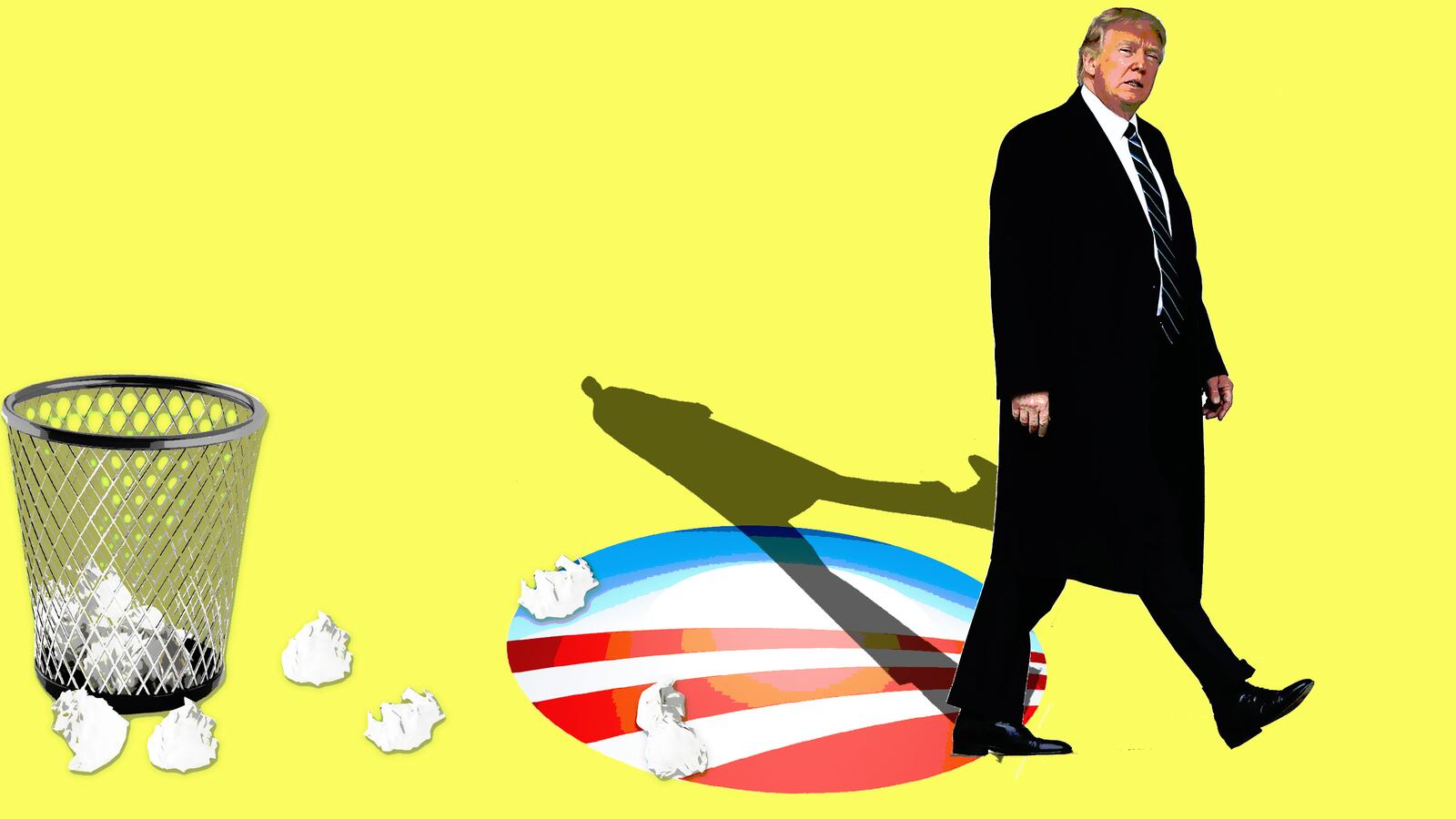Over the past month, the top health officials in the Trump administration have done more to encourage people to eat a healthy Thanksgiving dinner than to promote Obamacare’s open enrollment period.
The official CMS Twitter account has put out two tweets total with respect to open enrollment: the first to announce that it had begun, the second to release data regarding the number of people who had signed up for plans on the exchanges.
The HHS account, meanwhile, has put out five tweets alerting followers to the ability to choose a plan. But during that same time period, the department tweeted nine times about the holidays, including instructions for how to cook a ham on Thanksgiving—“make sure it’s cooked to 145 degrees”—and a link to “creative ways to use your holiday leftovers.”
The actual heads of the agencies have done even less. CMS Administrator Seema Verma has not tweeted about open enrollment once since the period to sign up for Obamacare plans began on Nov. 1.
The absence of a concerted push, let alone any push at all, is another facet in a longstanding attempt by the administration to either undermine Obamacare or facilitate its demise through neglect. A lack of tweets from top officials won’t have a massive impact on the final enrollment numbers, experts say, since few potential consumers are making purchasing decisions based off what Verma or Hargan say through that particular medium.
But collectively, the refusal of Trump administration officials to promote Obamacare—from shortening the open enrollment period to six weeks (it ends Dec. 15) to massively reducing television and digital advertising to cutting budgets for local outreach officials—is likely to have a major impact.
“The administration is not hiding the fact that they don’t want people to sign up for health coverage,” said Lori Lodes, a former top CMS official and the co-founder of the pro-Obamacare group, Get America Covered. “With only 10 days left before the December 15 deadline, they still haven’t engaged in the very basic public education that is needed to help people sign up for coverage. The Open Enrollment period is half as long and there are no TV ads and a fraction of the digital outreach—but they also refuse to use the basic tools of their positions and of the federal government to get the facts out."
In addition to the lack of tweets, neither Verma nor Hargan nor anyone from the Trump administration have held enrollment events for Obamacare on the day enrollment began—something their predecessors did in strategic stops across the country during past enrollment periods.
Randy Pate, the head of the CMS office that oversees Obamacare implementation, has been particularly quiet too. He did a private call with state exchange officials and publicly praised some of the top Obamacare brokers. Beyond that, there is little from him pushing enrollment. Verma and Hargan have barely discussed enrollment publicly. And when they have, it’s been largely negative.
Weeks before enrollment began, Verma declared that the agency was “making sure that people are aware of their choices and their options,” before adding, “the reality is Obamacare is not working.” In two appearances in November, she encouraged Medicare beneficiaries to enroll in coverage but didn’t mention Obamacare recipients. She also called the major increases in Medicaid enrollment—which have come courtesy of Obamacare’s Medicaid expansion—as a “hollow victory.”
Hargan commented on open enrollment when it began on Nov. 1, saying that officials at HHS had “put a great deal of work into preparing” for the season. But during that same appearance before the Council for Affordable Health Coverage, he also declared that ObamaCare has “failed.”
Even communications with lawmakers has been spotty. Sen. Angus King (I-ME) has, for instance, asked Verma to delay the deadline for Maine owing to a storm that knocked out power to nearly half a million people in the state. The Senator’s office has yet to receive a formal response, a spokesperson said. Though “Senator King’s conversations with Administrator Verma have left him feeling that she was taking the request very seriously.”
A White House official referred questions to HHS. A request for comment to HHS was not returned.
Despite all this, enrollment has moved along fairly well. Charles Gaba, who runs the site ACAsignups.net, which is widely credited with having the most pinpoint Obamacare numbers, estimated that as of today there were roughly 4.7 million people signed up through Healthcare.gov and another 1.9 million through the state exchanges. He suspects that the final tally will be roughly 10 million enrolled, which would be lower than the 12.2 million in 2017. That said, Gaba also wouldn’t rule out the possibility of a “massive last minute spike” when the Dec. 15 deadline neared due to some states having extended deadlines and the fact that subsidized enrollees would be eligible for dirt cheap, if not altogether free, coverage in many areas because of changes to the law.
Garba also noted that while the Trump administration had sat on its hands, pro-Obamacare advocates had redoubled their efforts to inform consumers of open enrollment. Which has been useful at a local level since the federal government has been absent there too.
Federal navigators, tasked with assisting constituents in the process of enrolling in the marketplace as well as educating people about their options, saw a major cut in funding from CMS earlier this year. And in the absence of a concerted effort from the federal government to get the word out, local organizations have mostly relied on their preexisting client lists and word-of-mouth to get people to sign up.
“People are not hearing about our services from the federal government,” Farah Erzouki, public health coordinator for the ACCESS Community Health and Research Center in Michigan told The Daily Beast. “They’re hearing it from other people in the community.”
ACCESS, which received a comparatively modest budget cut of 33 percent, particularly helps the metro Detroit area’s Arab-American population, some of whom use English as a second language.
Against these odds though, Erzouki said ACCESS is seeing an extremely high interest in enrollment and success in getting people through the door.
“Honestly we’re booked up until the end of open enrollment,” Erzouki told The Daily Beast “Our navigators have been so incredibly busy. All of this uncertainty is making folks only want to enroll even more.”
Other navigator programs have employed more creative means to ensure that people are aware of enrollment dates.
Florida Covering Kids & Families at the University of South Florida in Tampa has been using some social media influencers to spread the word, according to Jodi Ray, the director of the program. Julius Thomas of the Miami Dolphins and Hassan Whiteside of the Miami Heat participated in a PSA for the organization and shared it to their wide audiences.
“We’re really trying to encourage people to make these appointments with the navigators or at least call the navigator line,” Ray told The Daily Beast, noting that counties impacted by Hurricane Irma received an extension for enrollment until the end of December.
Ray’s program, she said, covers the entire state of Florida under their grant and saw almost a $900,000 budget cut.
“You can certainly buy a lot of navigators with $900,000,” Ray said. “We definitely saw our efforts impacted by that.”







